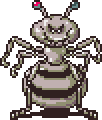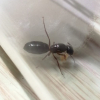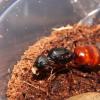1. Location (on a map) of collection: Newark, Delaware (New Castle County)
2. Date of collection: June 23, 2021
3. Habitat of collection: edge of parking lot, near an open field
4. Length (from head to gaster): ? N/A
5. Color, hue, pattern and texture: reddish orange
6. Distinguishing characteristics: has a "wide-eyed" look of a Lasius ant; lots of hairs on thorax, some towards back of head
7. Distinguishing behavior: quite active; chews cotton ball
8. Nest description: N/A
9. Nuptial flight time and date: probably sometime in June
Attached are photos of the two ants I caught tonight. To me, they look to be the same species (whatever that may be). Although I am still new at this, if I were to guess their ID, I would say either some type of Lasius sp. or Pheidole sp. I'm making that guess based off of previous ant ID'ing threads I've started and had answered buy the forums. Specifically, these two ants seem to look an awful lot like the ant I asked about in this thread: https://www.formicul...ewark-delaware/
However, in the post in which the ant was identified as Pheidole sp., there appeared to be striations on the top of the head. For the two current ants in question, I do not see any of this light pattern of ridges on the front of the face....perhaps it is just the angle of light in the photographs? Another difference is that both of these two ants I am asking about today are really quite active. One was even chewing on the cotton aggresively up to 2 hours after I put her in a test tube. The first ant I caught (identified as Pheidole sp.)had a very calm temperament Is this a difference between two different species? Or do ants have different temperaments/"personalities" from one another --even within the same species? Any insight the forum could provide would be greatly appreciated. Thanks!



















